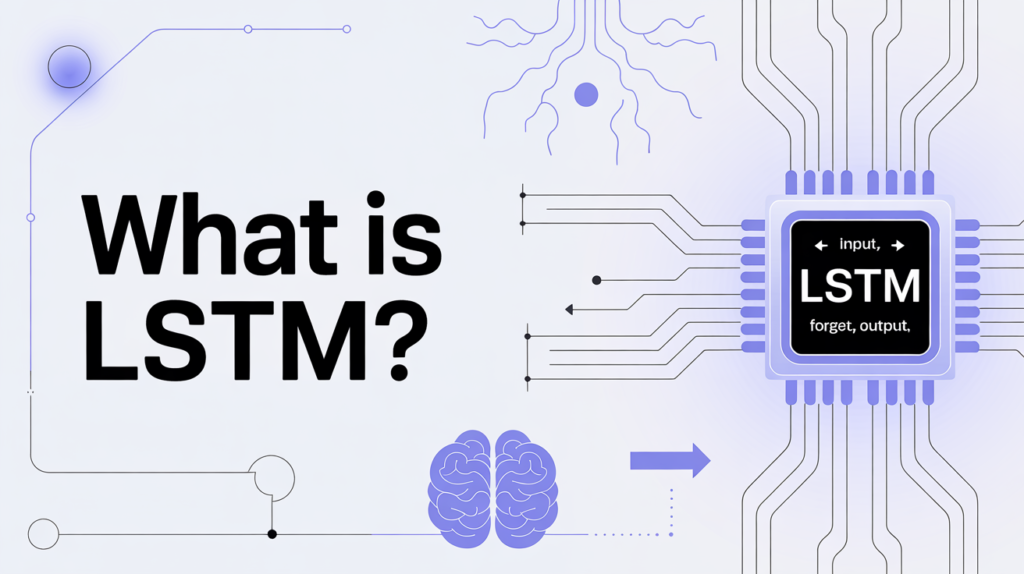What is LSTM? A Complete Guide to LSTM in Deep Learning

If you’ve ever wondered what is LSTM in deep learning, you’re not alone. Long Short-Term Memory networks, or LSTM networks, are a type of recurrent neural network (RNN) that have become essential in modern AI workflows — especially when it comes to processing sequential data like text, speech, or time series.
In this guide, we’ll break down, explore how it works, see what and why it is used for, and discover why it’s one of the most powerful tools for tasks involving context and memory.
A Quick Recap: From Perceptron to LSTM
Before diving deeper into LSTMs, let’s take a step back and understand the evolution of neural networks.
A Perceptron is the simplest type of artificial neuron that makes basic binary decisions. It laid the foundation for multi-layer neural networks, eventually leading to RNNs (Recurrent Neural Networks) and finally the more sophisticated LSTM networks.
Read more about perceptrons and their history on DeepAI.
How RNNs Work — And Where They Fall Short
RNNs are designed to process sequential data by maintaining a hidden state that captures information from previous steps. However, RNNs often struggle with long-term dependencies because of the vanishing gradient problem — where older signals get lost as the sequence grows.
That’s where LSTM networks come to the rescue.
What is LSTM? Understanding the Core Concept
So, LSTM stands for Long Short-Term Memory. It’s a special kind of RNN architecture that solves the vanishing gradient problem by introducing a memory cell and gates to control information flow.
These gates — the input, output, and forget gates — enable the LSTM to remember or forget information over long periods. This makes LSTMs perfect for tasks where context matters.
Real-World Applications:
What is LSTM used for in practice? Let’s look at some impactful applications:
- Time Series Forecasting: LSTM time series models are widely used in finance, weather prediction, and sales forecasting.
- Speech Recognition: LSTM networks handle sequential audio signals to improve voice recognition systems.
- Language Modeling: Many NLP tasks like machine translation, sentiment analysis, and text generation use LSTMs.
- Anomaly Detection: LSTM-based models can detect unusual patterns in data streams, helping in fraud detection and predictive maintenance.
Explore real LSTM applications on TensorFlow’s official tutorials.
How Does it Work? A Simple Walkthrough
Let’s break it down step by step:
- Input Gate: Decides which new information to store.
- Forget Gate: Decides what information to discard.
- Cell State: Stores values over time — this is the ‘memory’.
- Output Gate: Determines the output at each time step.
This architecture allows LSTMs to maintain and update relevant information for long sequences.
Benefits of Using:
Understanding it, wouldn’t be complete without recognizing its benefits:
- Handles long-term dependencies better than vanilla RNNs.
- Reduces the vanishing gradient problem.
- Works well with unstructured sequential data.
- Adaptable to various domains — from finance to healthcare.
LSTM vs GRU: What’s the Difference?
You might have heard of GRU (Gated Recurrent Unit). It’s another type of RNN that’s similar to LSTM but with a simpler structure. GRUs can be faster to train but may not capture complex patterns as well as LSTMs in some cases.
Compare LSTM vs GRU on Machine Learning Mastery.
Getting Started: Building Your First LSTM Model
You can build an LSTM using frameworks like TensorFlow or PyTorch. Here’s what you need to know:
- Data Preprocessing: LSTMs require input sequences to be of equal length. Padding and truncating help here.
- Choosing Hyperparameters: Number of layers, hidden units, dropout rate, and learning rate.
- Training and Evaluation: Use sequences to train and validate your model. Keep an eye on overfitting.
Try a practical LSTM time series forecasting example on Kaggle.
How LSTM Fits Into Modern Deep Learning
In modern AI pipelines, LSTMs are often combined with attention mechanisms or even replaced by Transformers for large-scale language tasks. However, they still play an important role, especially when computational resources are limited.
Challenges and Limitations of LSTM Networks
No technology is perfect. Despite their power, LSTMs can be computationally intensive and challenging to tune. Training LSTMs on very long sequences can still be tricky compared to newer architectures.
Future of LSTM Neural Networks
While Transformers dominate today’s NLP space, LSTMs remain a practical choice for many sequence problems. Understanding LSTM and how it works gives you a strong foundation for tackling complex time-dependent tasks.
FAQs About What is LSTM
1. LSTM in deep learning?
LSTM stands for Long Short-Term Memory, a type of RNN that can remember long-term dependencies in sequential data.
2. LSTM used for?
LSTMs are used for time series forecasting, language modeling, speech recognition, and more.
3. What are the advantages of LSTM over RNN?
LSTMs solve the vanishing gradient problem, making them better at remembering information over longer sequences.
4. Is LSTM better than GRU?
It depends on the task. LSTM is more powerful for complex patterns, while GRU can be faster to train.
5. Where can I learn to build an LSTM model?
Start with official tutorials on TensorFlow or PyTorch.
🧩 Get Started: Check Out These Guides on Python Installation
Working with LSTM neural networks often means setting up Python correctly, managing multiple versions, and creating isolated environments for your deep learning experiments.
To make sure your LSTM models run smoothly, check out these helpful blogs on Python installation:
📌 Python 3.10 Installation on windows
📌 Python 3.13 (latest) installation guide – easy and quick installation steps
Discover more from Neural Brain Works - The Tech blog
Subscribe to get the latest posts sent to your email.
